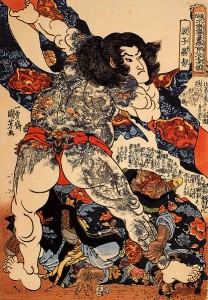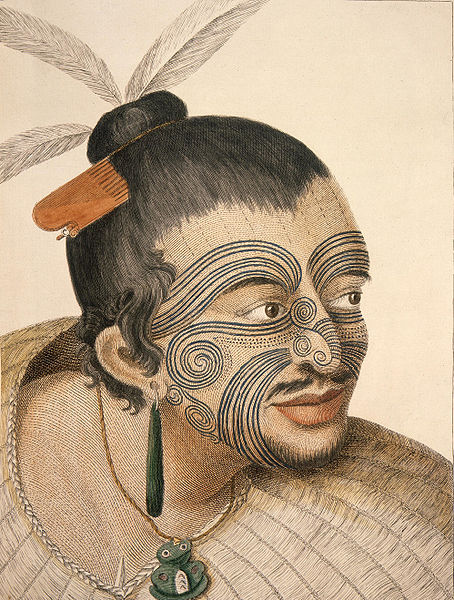A few years ago, when I was working in a somewhat gritty part of downtown Vancouver, I spotted a tough looking man with an unusual set of facial tattoos. On the right side of his face, someone had inked two or three teardrops falling from the corner of his eye. I wasn’t sure what these tattoos meant to him, but my instinctive reaction was to give the guy a wide berth. I had read somewhere that such crocodile tears were a criminal emblem, something to do with the number of people the tattoo wearer had murdered.
Over the past year, I have gotten to know someone with similar teardrop tattoos. The markings, to my surprise, had an innocent meaning, but they had played a tragic role in his life. B, as I will call him, is a Native American, a member of the Cherokee people. In his youth, B had lost in quick succession the two most important people in his life: his adopted father and his grandfather. He struggled with grief and wanted be reminded always of all they had meant to him. He chose to do so with two tattooed tear drops. A few years later, at the age of 23, B was arrested for a serious crime he says he did not commit: he was convicted, and at his sentencing the judge referred to his facial tattoos as a reason for doling out an especially harsh sentence.
After hearing B’s story, I began thinking and reading about tattoos and their meanings, particularly those tattoos favored by other cultures.  In Copper-Age Europe, some of these markings seem to have served a medicinal purpose. Oetzi, the 5200-year-old man who melted out of a glacier in Italy’s South Tyrol during an unseasonably warm summer two decades ago, brandished more than 50 of the inkings. Most were groups of crosses or barcodelike black lines and they appeared mainly on or near his joints and spine. Quite likely, the process of tattooing was a form of pain relief. The markings correspond to points used by modern Chinese acupuncturists, suggesting that this therapy has a much earlier history in Eurasia than previously thought.
In Copper-Age Europe, some of these markings seem to have served a medicinal purpose. Oetzi, the 5200-year-old man who melted out of a glacier in Italy’s South Tyrol during an unseasonably warm summer two decades ago, brandished more than 50 of the inkings. Most were groups of crosses or barcodelike black lines and they appeared mainly on or near his joints and spine. Quite likely, the process of tattooing was a form of pain relief. The markings correspond to points used by modern Chinese acupuncturists, suggesting that this therapy has a much earlier history in Eurasia than previously thought.
Elsewhere, people tattooed themselves for a wide range of reasons. By tradition in the Eastern Arctic, tattooing was largely women’s business. When a girl reached sexual maturity, she was presented to the best seamstress in the region—generally an elderly woman highly skilled in stitching animal skins to make waterproof kayak covers or warm kamuks. The seamstress would choose the finest bone needle in her tool kit, and begin stitching elaborate lines on the girl’s face. By inserting a tiny soot-covered pine splinter into each stitch, she permanently colored the lines, which formed elaborate patterns. These testified to the girl’s toughness and ability to endure pain, and were thought to enhance her spiritual ability to call game for her husband to hunt.
Indeed in most cultures, tattoos—particularly facial tattoos—serve as powerful forms of communication. The medium is the message, symbolizing membership in particular clans, sexual maturity and therefore marriageability, prowess in war, spiritual power, and many other things. But the ancient Chinese seem to have taken this concept further still.
In a recent post for a fascinating linguistic blog called Language Log, Sinologist Victor Mair observes that the “earliest (around 1200 BC) Chinese character for writing, wén 文, originally depicted and referred to tattoo.” In other words, early Chinese scribes used just one character to mean both writing and tattoo, strongly suggesting that the two shared a common ancient history. Today wén has acquired two other important meanings: culture and civilization. “Thus,” notes Mair, “there is a direct and unmistakable connection between tattoo and the development of writing in China.
What is in a tattoo? A great deal, it seems—misunderstanding, mistaken identity, therapy, writing, civilization.
Illustrations: Tattooed Maori chief by Sydney Parkinson, 1745-1771; Tattooed wrestler by Utagawa Kuniyoshi (1797–1861)

The culture of getting a tattoo was then introduced in Europe by sailors. They would get themselves tattooed as a reminder of their journey to a new found land.
I personally suspect that the tradition of tattooing persisted in Europe long after era Iceman times. I think that the evidence is spotty because there aren’t too many naturally preserved mummies from later periods. However, there’s a really nice paper that Agnieszka Marczak wrote on the history of tattoos in Europe and elsewhere, based on the archaeological and historical evidence. Here’s the link:
http://digitalcommons.ric.edu/cgi/viewcontent.cgi?article=1029&context=honors_projects&sei-redir=1&referer=http%3A%2F%2Fscholar.google.ca%2Fscholar%3Fhl%3Den%26q%3Dtattoo%2Bmedieval%2BEurope%26btnG%3D%26as_sdt%3D1%252C5%26as_sdtp%3D#search=%22tattoo%20medieval%20Europe%22